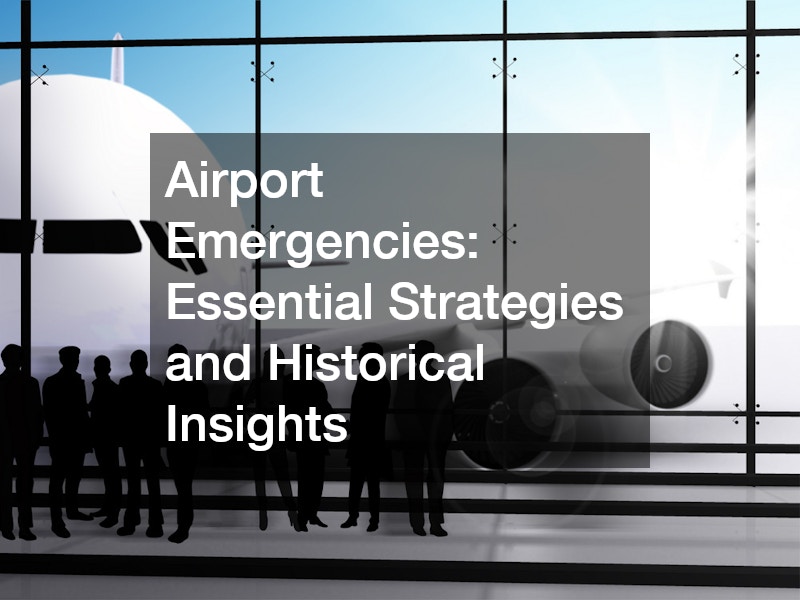

Airport emergencies are a critical aspect of aviation safety and efficiency. Regardless of how advanced an airport is, without a robust emergency plan, it is vulnerable to a range of crises that can disrupt operations and endanger lives. Understanding the types of emergencies that can occur and the strategies for managing them is essential for ensuring a safe and well-prepared aerodrome.
Types of Airport Emergencies
Airports face various types of emergencies that can affect their operations:
Aircraft Incidents and Accidents:
These include crashes or forced landings both on and off the airport premises. Such incidents require immediate coordination between multiple emergency services to manage the situation effectively.
Security Threats:
Bomb threats, hijackings, and other security breaches pose significant risks to airport safety. These threats necessitate swift, coordinated responses to ensure passenger and staff security.
System and Communication Failures:
Failures in critical systems or communication networks can disrupt airport operations and lead to confusion. Ensuring redundancy and regular system checks are vital for minimizing the impact of these failures.
Structural Emergencies:
Damage to airport infrastructure, such as runways, terminals, or control towers, requires rapid assessment and repair to restore normal operations.
Fire Threats:
Fires in any part of the airport, whether in buildings or on aircraft, demand a quick response to prevent widespread damage and ensure safety.
Dangerous Goods and Hazardous Materials:
Spills or accidents involving hazardous substances can pose significant risks. Proper handling procedures and emergency response plans are crucial for managing such incidents.
Medical Emergencies:
These can range from sudden health issues among passengers to injuries resulting from accidents. Prompt medical attention and coordination with emergency medical teams are essential.
Natural Disasters:
Adverse weather conditions, earthquakes, or other natural events can impact airport operations. Preparedness for such events is crucial to mitigate their effects.
Airspace Restrictions:
Restrictions due to military operations or other factors can affect flight schedules and airport operations. Effective communication and planning are necessary to manage these restrictions.
Cybersecurity Attacks:
As airports increasingly rely on digital systems, cybersecurity threats can compromise operations. Ensuring robust cybersecurity measures and response plans is vital for protecting sensitive information and maintaining operational integrity.
Historical Perspective and Evolution of Emergency Planning
The evolution of airport emergency planning can be traced back to significant incidents that highlighted the need for improved safety measures. A pivotal moment in this history occurred on August 2, 1985, when Delta Airlines Flight 191 crashed at Dallas-Fort Worth International Airport due to microburst winds. This tragic event underscored the necessity for comprehensive emergency planning and response strategies.
In response to this incident, significant changes were made across the aviation industry. The National Transportation Safety Board (NTSB) recommended regular, full-scale emergency exercises to prepare airports for potential crises. This led to the Federal Aviation Administration (FAA) introducing a four-phase concept of emergency management: Prevention, Preparedness, Response, and Recovery.
The Four Phases of Emergency Management
1. Prevention:
The first phase involves taking measures to avoid or mitigate potential disasters before they occur. This includes implementing safety procedures, investing in training and equipment, and raising awareness among the public and staff about potential risks.
2. Preparedness:
This phase focuses on readiness before an emergency occurs. It includes developing detailed emergency plans and policies, training staff, and conducting regular drills to ensure that everyone knows their roles and responsibilities in a crisis.
3. Response:
In the immediate aftermath of an emergency, effective response is critical. This phase involves executing emergency plans, coordinating with various agencies, and making swift decisions to manage the situation. Clear communication and a structured approach are essential for a successful response.
4. Recovery:
The final phase aims to restore normal operations as quickly as possible. It involves rebuilding infrastructure, managing the aftermath of the crisis, and learning from the incident to improve future preparedness and response.
The Role of Emergency Response Teams
An effective emergency response relies on a well-organized team. The Emergency Response Team (ERT) typically includes high-level executives and support staff from various departments, such as fire and rescue, police, medical teams, and airport authority personnel. In the event of a major emergency, the ERT activates the Emergency Control Center and coordinates efforts with on-site mobile command posts.
The primary objectives of the emergency response are to save lives, reduce damage, assist in investigations, and resume normal operations. This requires quick decision-making, effective communication, and a coordinated effort from all involved parties. Moreover, managing resources effectively is crucial, including the storage and accessibility of aircraft parts. Proper aircraft parts storage ensures that critical components are available when needed for swift repairs and maintenance, minimizing downtime and aiding in a faster recovery process.
Key Takeaways
Airport emergencies, while challenging, can be managed effectively with proper planning and response strategies. By understanding the types of emergencies that can occur and adhering to the four phases of emergency management, airports can enhance their preparedness and response capabilities. The commitment of emergency response teams and ongoing education and training play crucial roles in ensuring the safety and efficiency of airport operations. As aviation continues to evolve, maintaining and improving emergency preparedness will remain a key component of effective airport management.
.


